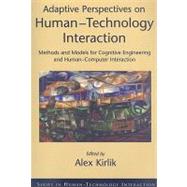
Note: Supplemental materials are not guaranteed with Rental or Used book purchases.
Purchase Benefits
What is included with this book?
| Foreword | p. vii |
| Contributors | p. xv |
| Background and Motivation | |
| Cognitive Engineering: Toward a Workable Concept of Mind | p. 3 |
| Introduction to Brunswikian Theory and Method | p. 10 |
| Technological Interfaces | |
| Introduction | p. 27 |
| Knowledge versus Execution in Dynamic Judgment Tasks | p. 29 |
| Understanding the Effects of Computer Displays and Time Pressure on the Performance of Distributed Teams | p. 43 |
| Supporting Situation Assessment through Attention Guidance and Diagnostic Aiding: The Benefits and Costs of Display Enhancement on Judgment Skill | p. 55 |
| Applying the Multivariate Lens Model to Fault Diagnosis | p. 71 |
| Automation and Decision Aiding | |
| Introduction | p. 89 |
| Measuring the Fit between Human Judgments and Alerting Systems: A Study of Collision Detection in Aviation | p. 91 |
| Trust, Automation, and Feedback: An Integrated Approach | p. 105 |
| Human-Automated Judgment Learning: Enhancing Interaction with Automated Judgment Systems | p. 114 |
| Alternatives to Compensatory Modeling | |
| Introduction | p. 129 |
| Inferring Fast and Frugal Heuristics from Human Judgment Data | p. 131 |
| Viewing Training through a Fuzzy Lens | p. 149 |
| Achieving Coherence: Meeting New Cognitive Demands in Technological Systems | p. 163 |
| Into the Field: Vicarious Functioning in Action | |
| Introduction | p. 177 |
| What Makes Vicarious Functioning Work? Exploring the Geometry of Human-Technology Interaction | p. 179 |
| Understanding the Determinants of Adaptive Behavior in a Modern Airline Cockpit | p. 197 |
| Abstracting Situated Action: Implications for Cognitive Modeling and interface Design | p. 212 |
| Ecological Analysis Meets Computational Cognitive Modeling | |
| Introduction | p. 227 |
| The Emerging Rapprochement between Cognitive and Ecological Analyses | p. 230 |
| The Use of Proximal Information Scent to Forage for Distal Content on the World Wide Web | p. 247 |
| Kilograms Matter: Rational Analysis, Ecological Rationality, and Closed-Loop Modeling of Interactive Cognition and Behavior | p. 267 |
| Reflections and Future Directions | |
| Reflections from a Judgment and Decision Making Perspective | p. 287 |
| Reflections from a Cognitive Engineering and Human Factors Perspective | p. 292 |
| Name Index | p. 297 |
| Subject Index | p. 303 |
| Table of Contents provided by Ingram. All Rights Reserved. |
The New copy of this book will include any supplemental materials advertised. Please check the title of the book to determine if it should include any access cards, study guides, lab manuals, CDs, etc.
The Used, Rental and eBook copies of this book are not guaranteed to include any supplemental materials. Typically, only the book itself is included. This is true even if the title states it includes any access cards, study guides, lab manuals, CDs, etc.